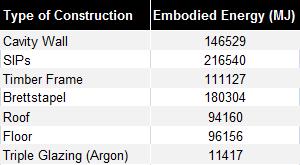
Project Overview
Construction
Occupancy
Behavioural models
Demand
Renewable technologies
Conclusion
Team
Acknowledgements
Construction
Results
In the following tables, there is a summary of the results for the four mentioned wall constructions. It should be underlined that in this part of the project, our objective was to identify the best wall construction for the building in terms of energy performance, i.e. space heating and embodied energy. Note that these simulations were run in ESP-r with the same conditions (casual gains for 3 people) since we were only seeking for the best material.
Table 1 shows the results for the wall constructions from the heating demand point of view, while Table 2 shows the embodied energy for these constructions.
Table 1 - Heating Results

Table 2 - Embodied Energy Results

As we can see, the wall construction with the highest embodied energy will be SIPs because it uses polyurethane foam as insulation, which EE is very high. After that, brettstapel and cavity wall due to their total thickness is larger than the rest of constructions and hence the best option in terms of embodied energy will be timber frame. Moreover, since the space heating demand for each of the different wall constructions is quite similar, the total embodied energy will become in the most important factor when choosing the ideal construction material regarding energy savings. Furthermore, TIMBER FRAME will be used in all the next ESP-r simulations for a variable occupancy.
